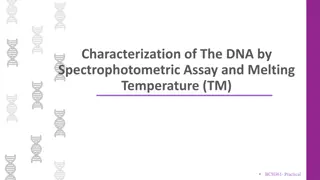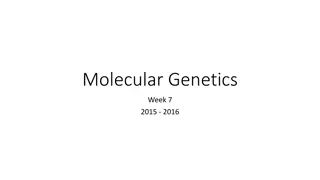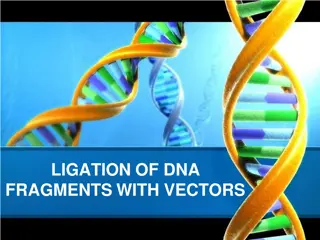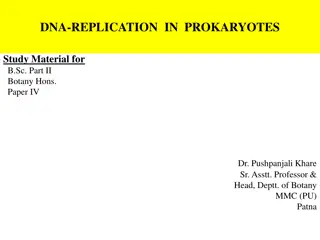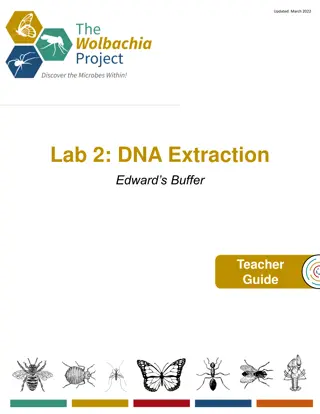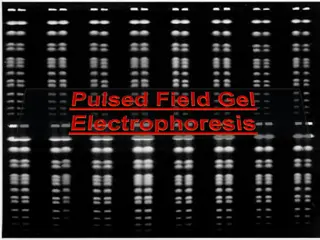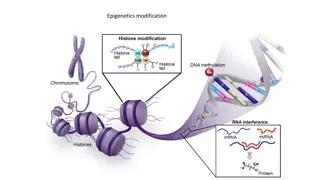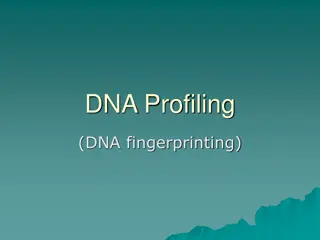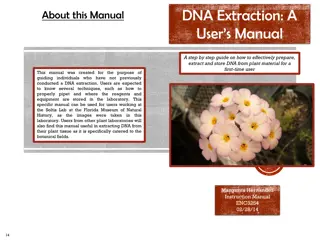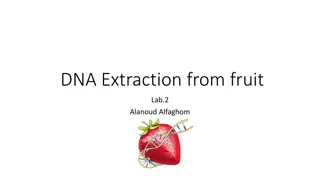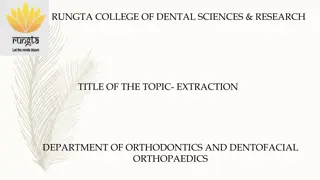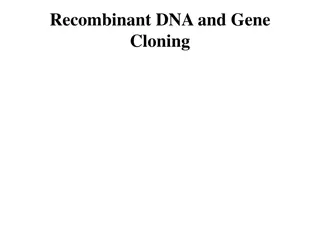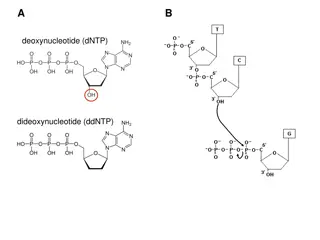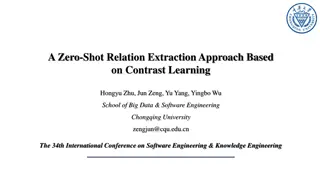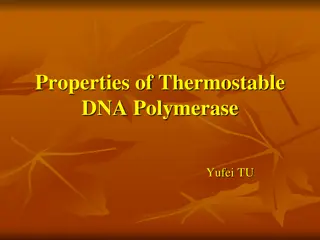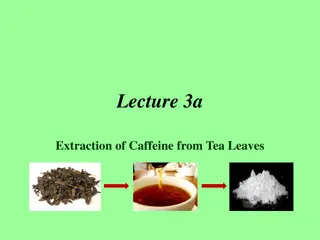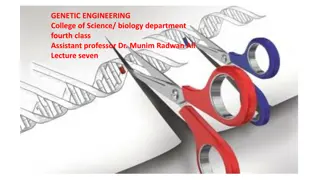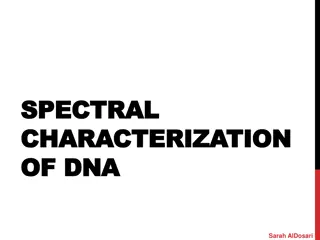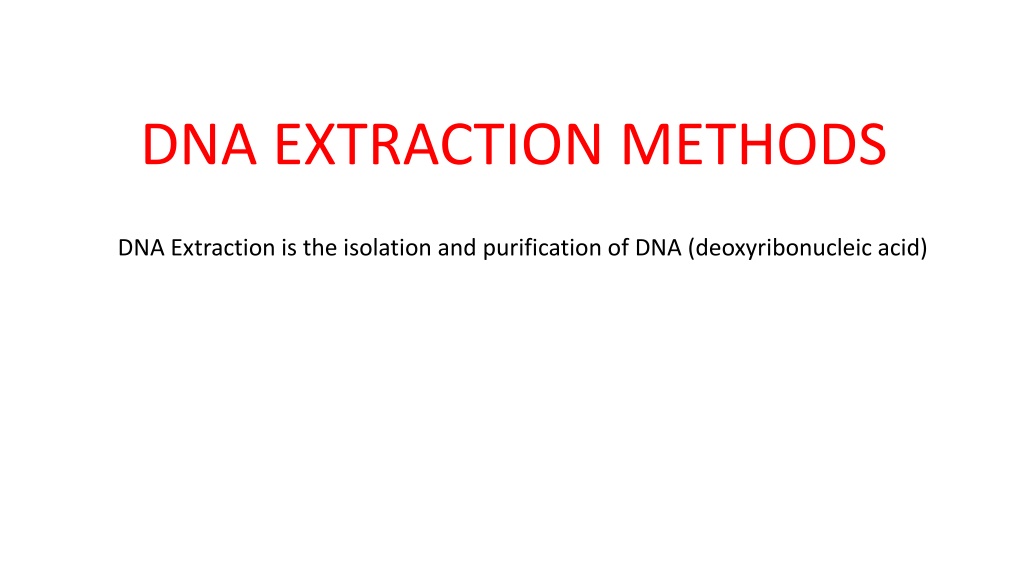
DNA Extraction Methods and Protocols
DNA extraction is a crucial process in isolating and purifying DNA for various applications such as PCR, RFLP, and Southern blotting. This extraction method allows for the recovery of DNA from sources like blood, tissues, saliva, hair, teeth, and more. The essential components of a DNA extraction procedure include maximizing DNA recovery, removing inhibitors, inhibiting nucleases, and ensuring DNA quality. Various methods like organic (PCI), inorganic (NaCl 6M), commercial kits, and CTAB are used for DNA extraction. The process involves key materials like lysis buffer, proteinase K, phenol-chloroform-isoamyl alcohol, SDS, and more. Lab equipment, such as pipettes, tubes, vortex, centrifuge, and proper blood sample handling, are essential for successful DNA extraction.
Download Presentation

Please find below an Image/Link to download the presentation.
The content on the website is provided AS IS for your information and personal use only. It may not be sold, licensed, or shared on other websites without obtaining consent from the author. Download presentation by click this link. If you encounter any issues during the download, it is possible that the publisher has removed the file from their server.
E N D
Presentation Transcript
DNA EXTRACTION METHODS DNA Extraction is the isolation and purification of DNA (deoxyribonucleic acid)
DNA EXTRACTION METHODS DNA extraction is used to isolate Types of DNA Mitochondrial DNA Genomic DNA Plasmid DNA How Can We Recover DNA From a Variety of Sources of Biological Evidence? Blood, Tissues, Saliva, Urine, Hair (w/Root & Shaft), Teeth, Bone, Semen, Cigarette Butts, Envelope & Stamps, Fingernail Clippings, Chewing Gum, Feces
Purpose of DNA Extraction To obtain DNA in a relatively purified form which can be used for further investigations such as: PCR (polymerase chain reaction) RFLP (restriction fragment length polymorphism) Southern Blotting
What are the essential components of a DNA extraction Procedure? 1. Maximize DNA recovery 2. Remove inhibitors 3. Remove or inhibit nucleases 4. Maximize the quality of DNA
How Much DNA Can We Recover? How Much DNA Can We Recover? A Diploid Cell contains approximately 6 pg of DNA The average WBC of an adult is 5 - 10 X 106 cells per ml of blood. Therefore, the theoretical recovery of DNA per ul of blood is 30 - 60 ng How Much DNA Do We Need? The PCR reactions call for on average 1 ng of DNA (single or double stranded)
DNA Extraction protocol 1. Organic Method (Phenol Chloroform Isoamyl [PCI]) 2. Inorganic Method (NaCl 6M) 3. Commercial available kits 4. CTAB (Cetyl trimethylammonium bromide): commonly used in the preparation and purification of genomic DNA from Plant
Material -Lysis buffer (TE) -Proteinase K -Phenol-chloroform isoamyl alcohol (PCI) -SDS 10% -TNE buffer -Isopropanol - Ice cold 95-100% ethanol - Ultrapure (DNA- & DNase-free) water
Lab equipment needed: -Pippetes, -1.5mL sterile microcentrifuge tubes or 15, 50 mL Falcons, -Racks, -Tips -Vortex - Freezer - Centrifuge Blood Sample Blood collection in anticoagulant i.e. Ethylenediamide tetra-acetic acid (0.5 M EDTA) containing tube 1.5 mL eppendorf or 15 mL Falcon tube Storage of Blood Samples Field blood samples should be place on ice immediately after their collection store in freezer at -20 C before DNA extraction
Steps in Organic and Inorganic DNA Extraction 1- Lysis of Red Blood Cells, RBC 2- Digestion step (Lysis of White blood cells, WBC) 3- Phase Separation step (Extraction of Protein) Organic DNA Extraction: PCI Inorganic DNA Extraction: 6M NaCl 4- DNA Precipitation 5- Washing with ice cold Ethanol 6- Dilute the pellet
1. Lysis of Red Blood Cells, RBC Lysis of red blood cells Added 800 uL of Tris EDTA buffer (Tris HCl 10mM, EDTA 2mM) in 200 uL ml of the blood. Mixed by inverting several times. Centrifuged at 5000 rpm for 10 min. Discarded the supernatant. Break the pellet formed at the bottom of the eppendorf tube by tapping it gently. Add 1 mL TE buffer and mixed it gently. Centrifuged at 5000 rpm for 10 min. this step may be repeated until pallet becomes light pink.
2. Digestion step (Lysis of White blood cells, WBC) Pellet obtained after lysis of RBCs re-suspended in 400 uL Buffer TNE (Tris HCL 10mM, EDTA 2mM, NaCl 400mM), 200 L 10% SDS 50 L Proteinase K (50 l of 10 g/uL conc.). Homogenize the tube with gentle rotation Samples incubate at overnight in 58 C in shaker water bath. Next Day
3. Phase Separation step (Extraction of Protein) In this step, we can remove the digested protein through 6M NaCl (Inorganic Method) or Phenol-chloroform isoamyl alcohol (PCI, in ratio 25:24:1 respectively) (Organic Method). DNA released into solution is extracted with PCI to remove proteinaceous materials. Add equal volume of phenol-chloroform-isoamyl (PCI) alcohol Mix gently for 2 min and centrifuge for 10 minutes at 10,000 rpm at 4C. Carefully remove the top (aqueous) phase containing the DNA using a 1000-ul pipette transfer to a new tube.
4. DNA Precipitation Precipitate the DNA with absolute isopropanol and inverted the tubes gently till DNA threads became visible and then left the tubes at room temperature for 10 minutes. Centrifuged at 8000 rpm for 10 minutes and discarded the supernatant carefully and white pellet of DNA may visible at the bottom of the tube.
5. Washing with ice cold Ethanol Washed DNA pellet with 1 mL of 70-100% ethanol, break and mix the pellet Then centrifuged at 8000 rpm for 10 minutes and discarded the supernatant carefully Air dried the DNA pellet at room temperature for at least 2 hours
6. Dilute the pellet Add 50-100 uL of low T.E. (Tris HCl 10 mL, EDTA 0.2mM) or DEPC water Place the tubes in a shaking water bath at 70 C for one hour so that nucleases were inactivated. Finally DNA will store at 20oC. Next DNA Quantifications


